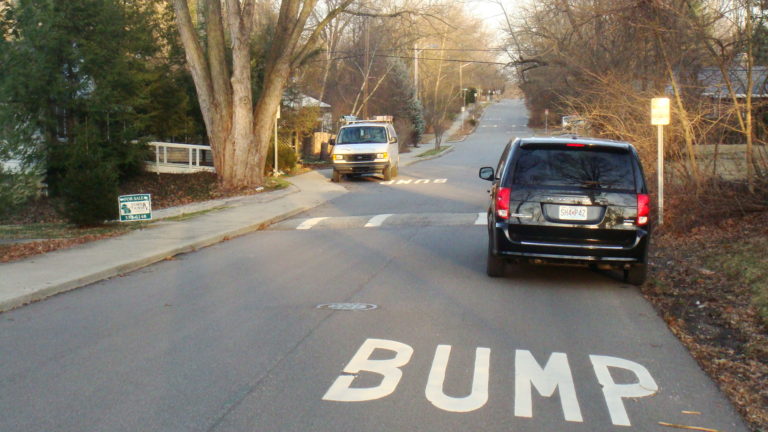Asphalt speed bumps are an effective way to slow down the traffic around your home or business and make it safer to cross the street. In fact, they have been shown to significantly reduce the number of car accidents on residential streets and in parking lots and garages. When you consider the number of lives saved, asphalt speed bumps could end up being one of the most cost-effective measures you can take to improve safety around your business or home.
What is an asphalt speed bump?
Asphalt speed bumps are raised areas of pavement, typically 10 to 15 feet long, designed to slow traffic. They are commonly used in residential neighborhoods and parking lots to help control traffic speed and keep drivers safe.
 Asphalt speed bumps are created from a mixture of materials poured onto your existing asphalt. This mixture is then tamped down and textured to create a long, sloping surface with deep grooves and ridges. Once these grooves and ridges are set, they form an effective barrier that forces drivers to slow down as they cross over it.
Asphalt speed bumps are created from a mixture of materials poured onto your existing asphalt. This mixture is then tamped down and textured to create a long, sloping surface with deep grooves and ridges. Once these grooves and ridges are set, they form an effective barrier that forces drivers to slow down as they cross over it.
Asphalt speed bumps tend to be steeper than concrete speed bumps, which causes them to rise higher above the pavement. This adds another safety element, in that you are less likely to catch a wheel on one of their slopes if you come too close while turning.
Key benefits of asphalt speed bumps
Speed bumps are usually made from asphalt because it is a durable material that can withstand heavy traffic and weather conditions without deteriorating. Asphalt is also a flexible material, which helps to prevent damage to vehicles if they hit the speed bump too fast.
But the benefits of asphalt speed bumps don’t end there!
 Asphalt speed bumps are a popular choice for traffic calming measures because they are relatively inexpensive to install and maintain. They can be placed directly on the asphalt surface without the need for special installation equipment or techniques.
Asphalt speed bumps are a popular choice for traffic calming measures because they are relatively inexpensive to install and maintain. They can be placed directly on the asphalt surface without the need for special installation equipment or techniques.
Additionally, they are effective at slowing down vehicles as their larger size and smooth surface make them more difficult to drive over at high speeds. Asphalt speed bumps are also highly visible, which can help increase driver awareness in areas where they are installed.
Who should use asphalt speed bumps?
Asphalt speed bumps are an ideal solution for schools, neighborhoods, parking lots, and any other areas where traffic needs to be slowed down. They are also a good choice for businesses that want to deter speeding vehicles from entering their property.
How to install asphalt speed bumps?
 Though asphalt speed bump installation can seem daunting, it is actually a lot easier than you may think. Let us walk you through the installation process so you can be confident that you are doing it correctly.
Though asphalt speed bump installation can seem daunting, it is actually a lot easier than you may think. Let us walk you through the installation process so you can be confident that you are doing it correctly.
- First, you need to mark the location of the speed bump with paint or flags.
- Next, you will need to excavate the area where the speed bump will go.
- Once the excavation is complete, you will need to install a base layer of asphalt.
- After the base layer is installed, you will need to install the speed bump itself.
- Once the speed bump is in place, you will need to compact it with a roller or tamper.
Understanding the asphalt speed bump installation process is important, but so is knowing how long the process will take. After installing the speed bump, you should give it some time to cool down. Because the asphalt is hot, you should erect a temporary barrier around it to allow it to cool. Asphalt can cool in as little as 30 minutes, but it is recommended to wait an hour or more.
When installing asphalt speed bumps, it is recommended to hire a professional asphalt contractor to ensure that your speed bumps are installed correctly.
Address
Commonwealth Paving, 136 Outerloop, Louisville, Kentucky 40214
Phone: 502-459-7283, Fax: 502-456-2678
Opening Hours
| Monday | 9:00 AM – 5:00 PM |
| Tuesday | 9:00 AM – 5:00 PM |
| Wednesday | 9:00 AM – 5:00 PM |
| Thursday | 9:00 AM – 5:00 PM |
| Friday | 9:00 AM – 5:00 PM |
| Saturday | Closed |
| Sunday | Closed |







